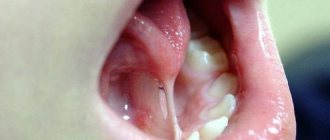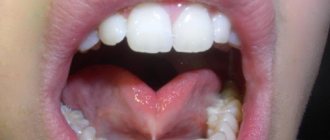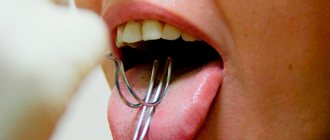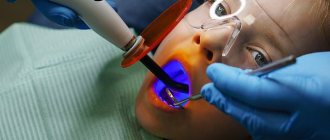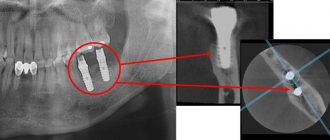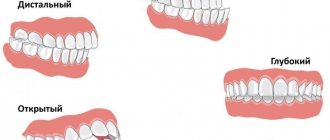If your child speaks poorly or you notice obvious signs of malocclusion in your baby, you should go for a consultation with a pediatric dentist. You can get rid of these and other problems with a simple procedure - you need to correct a short frenulum of the tongue in a child.
The frenulum of the tongue is a bridge that connects the tongue and the lower palate. It is responsible for how the tongue functions, affects speech, the ability to drink and eat, and swallow. The condition of the frenulum even affects the breathing process!
Here there is the possibility of pathology consisting in insufficient length, which leads to the recommendation to trim the frenulum of the child’s tongue. Why is it needed?
Let's consider the reasons for the need for this operation for children from a very early age. For newborn babies, sucking is a vital function. It is she who suffers in case of frenulum pathology. If it is not trimmed, the baby will not be able to drink mother's milk, including from a bottle with a nipple. It must be said that surgery in early childhood is easier to tolerate than in adulthood, so parents should not worry about the baby’s well-being.
Further, if a short frenulum of the tongue is detected at an older age, doctors advise surgery to prevent the defect from affecting the formation of the bite, and to avoid speech problems and disturbances in the process of eating.
Short frenulum of the tongue - what is it?
But let's look at the problem in more detail. So, short frenulum of the tongue - what is it? The bridge connecting the tongue to the palate, or simply a special ligament if not long enough, significantly reduces the mobility of the tongue. It would seem that this is a trifle. However, children with this problem very clearly suffer from inconvenience. Moreover, it gets worse with age. When baby teeth are replaced by permanent ones, a short frenulum will not allow the dentition to form correctly, which almost always carries a high risk of caries, gum disease and other unpleasant problems.
There are 5 different types of pathology, each of which brings specific discomfort to the child’s life:
- thin and transparent - limits the mobility of the tongue;
- thin and translucent - causes a semblance of bifurcation of the tip of the tongue when directed upward;
- thick - limits the mobility of the tongue;
- dense and very short, combined with the muscles of the tongue - along with cleft lips and palate;
- dense and very short, combined with the muscles of the tongue, severely limits the mobility of the tongue.
The next question naturally arises: who to turn to? If the baby is unable to stick out his tongue or reach his upper teeth, we can conclude that there is a possibility of pathology. However, the final verdict must be made by a professional. The specialist who will make the appropriate diagnosis must conduct an examination of the oral cavity. Most often this is a dentist, but doctors of other specializations can also evaluate the elasticity and length of the frenulum, the normal value of which is 8 mm for 5 years of age.
Most often, a short frenulum is a congenital pathology, including hereditary. The cause of the defect in the child can be viral diseases, stress, toxicosis or other factors during the mother’s pregnancy. It is important to understand that even in the absence of obvious discomfort, trimming is necessary to eliminate the risk of problems in the future.
How to fix the problem and who to contact? The decision on the length of the tongue frenulum is made by parents during a consultation with a dentist. The defect can be eliminated surgically or with the help of special gymnastic exercises for articulation.
The method of eliminating the defect is selected by the dentist individually depending on parameters such as the degree of shortening, the presence of consequences, localization, and the age of the child.
Which method is suitable in your case depends on the surrounding circumstances. So, if a short frenulum is discovered in the first days of a child’s life and directly affects his nutrition, surgery on the frenulum of the tongue is necessary, which is often performed right in the maternity hospital. Please note that for newborns the process will be completely painless! It is also worth operating if an incorrect bite is formed or has formed. After frenuloplasty, the child will experience some discomfort associated with a change in diction. This is a temporary phenomenon that can be easily eliminated by classes with a speech therapist and special gymnastics for the tongue.
If a child has a burr, speech therapy disorders associated with pronunciation and speech can be corrected by performing a set of exercises to develop and stretch the frenulum.
Causes of the defect
The anomaly occurs during intrauterine development. The provoking factors of a short frenulum of the tongue are:
- fetal infection;
- viral diseases that occur during the first and last trimester of pregnancy;
- genetic predisposition, heredity;
- unfavorable environmental background;
- abdominal injuries of a pregnant woman;
- chronic somatic diseases of the expectant mother.
The decisive factor is heredity. It was noted that among parents who personally encountered a similar pathology, their children often also needed frenulum correction.
At what age should this be done?
If we talk about a non-surgical method for stretching the hyoid ligament, it is effective up to the age of 5 years with constant and regular training.
The operation as a whole has no restrictions and no special recommendations about at what age it should be done. Each stage of development of a child’s body requires one of several ways to correct this ligament. Thus, newborns undergo a dissection of the frenulum, and already at the age of 2–3 years, when the tissue of the ligament becomes denser, the need for sutures arises. Sometimes it may be necessary to remove some of the ligament tissue. Laser surgery has no age restrictions.
To avoid the formation of malocclusion and displacement of the dentition, it is advisable to correct the frenulum before the molars appear.
How is the operation performed?
Preparation for such a surgical intervention comes down to thorough sanitation of the oral cavity, because any infection in it can provoke complications. It is necessary to undergo an examination to ensure that there are no contraindications to such an intervention.
This operation does not require special preparation, since the procedure is low-traumatic. Before performing it, doctors advise patients to be full, because such an intervention is less tolerated on an empty stomach, and hunger is an additional stress, which causes the blood to clot more slowly.
One of the important conditions for performing an operation in childhood is to ensure that the little patient sits quietly in a chair for at least 10-15 minutes. The procedure does not cause discomfort and is absolutely painless; during the procedure, the baby can sit with his mouth slightly open, and is even able to talk.
How to correct a short frenulum of the tongue?
Let's consider a surgical method to solve the problem. How to correct a short frenulum of the tongue? There is a scalpel method and laser surgery. The first involves mechanical incision (in one of several options) and suturing of the ligament if necessary. All this takes place under local anesthesia. The operation takes on average 30 minutes.
Frenumplasty can be performed in different ways. It is possible to make incisions to the ligament followed by sutures in the lower and upper parts, incisions on the sides, as well as moving the attachment site of the ligament.
The recovery period lasts about a week. At this time, swelling and slight pain may occur. After 10 days, the stitches will begin to dissolve. During recovery, care must be taken when eating, and the baby's parents should monitor this. In addition, the dentist may recommend rinsing the mouth with a special solution or using healing medications.
NEW LEVEL
THERE ARE TWO IMPORTANT CONCEPTS ABOUT WOUND SURFACES IN THE ORAL CAVITY:
1. Healing and contraction of any open wound in the oral cavity occurs towards its center (hence the need to keep it as open as possible).
2. Two moist surfaces in the mouth that are in direct contact with each other re-grow well.
I believe stretching is necessary after a frenulum trimming procedure to achieve optimal results. The exercises do NOT require the use of force and do not take much time. It is necessary that the movements be fast and precise. Using an LED headlamp will help you achieve the best results.
To relieve pain, you can use Tylenol, Ibuprofen (if baby is 6 months or older), Arnica, Rescue Remedy (Ed. - Dr. Gaeri's recommendation), or other medications. I also recommend purchasing a soothing teething gel (without benzocaine or lidocaine, which are numbing ingredients), such as Hyland's Teething Gel or Orajel Naturals (not regular Orajel). These gels should be used during stretching exercises, and they will also help relieve pain immediately after completing the warm-up.
The main danger of cutting the frenulum is that wounds in the mouth heal very quickly. This can cause premature fusion, whether of the tongue or lip, resulting in new limitation of mobility and persistence or return of symptoms. The exercises shown below are best done with your baby lying on your lap (or on the bed) with his feet pointing away from you.
PRINCIPLES OF PERFORMING STRETCHING EXERCISES: WATCH THE VIDEO https://vimeo.com/86784777
STRETCHING
SIGNIFICANT DISCHARGE OR BLEEDING AFTER THE FRENALE CUT PROCEDURE IS CONSIDERED NORMAL, ESPECIALLY IN THE FIRST FEW DAYS. BLEEDING IS REDUCED TO A MINIMUM BECAUSE THE PROCEDURE IS CARRIED OUT WITH A LASER. BEFORE STARTING THE EXERCISES, WASH YOUR HANDS CAREFULLY (GLOVES ARE NOT NEEDED). APPLY A SMALL AMOUNT OF SOOTHING GEL ON YOUR FINGER BEFORE STARTING TO WARM UP. I RECOMMEND DOING THE EXERCISES 4 TIMES A DAY FOR THE FIRST 3 WEEKS AND THEN DURING THE 4TH WEEK, QUICKLY REDUCING THE NUMBER OF EXERCISE REPEATS FROM 4 TO 3, 2, 1 REPS PER DAY BY THE END OF THE 4TH WEEK.
Scheme by Dr. Sherwin Yazdi. The wounds are usually diamond shaped. It has 3 dimensions - height, width and depth. This is especially important for the sublingual wound, since it is much deeper than the wound under the lip. Working along these 3 dimensions is the key to successful healing.
The upper lip stretches more easily than the tongue. If you need to stretch your lip and tongue, I recommend starting with lip exercises. As a rule, children do not like this warm-up and may cry. This way, lip exercises allow for easier access under the tongue when the baby starts to cry. For the upper lip, simply place your finger under the lip and push it as high as possible (until you feel resistance). Then gently move your finger from side to side for a few seconds. Remember, the main purpose of this procedure is to use your finger to separate the moist opposing surfaces, the lip and gum, so that they cannot stick to each other.
The next area of stretching work is the tongue . Place both index fingers in your mouth (insert one first and move it toward your cheek to stretch your mouth, making room for the second index finger). Then use both index fingers to place them under your tongue and lift it towards your upper palate. You need to perform three separate stretching movements with your tongue:
1. With your fingers under your tongue, try to lift your tongue as high as possible (towards the upper palate). Hold it in this position for 1-2 seconds, then relax your fingers and repeat these steps again. The goal of the exercise is to fully open the diamond so that it is almost in the same plane (remember, the central horizontal fold line of the diamond is the place where fusion will first begin).
2. Lift and hold your tongue with one finger, place the other finger horizontally in the middle of the diamond and roll it like a roller from front to back, try to stretch the diamond as high as possible. Make sure that your finger movements when stretching this area are performed within the diamond. After this, repeat the movement on either side of the diamond (outside the diamond) to relax the muscles in the rest of the hyoid space.
WATCH THE VIDEO https://vimeo.com/98709935
SUCKING EXERCISES
It is very important to let your baby understand that not all manipulations that you perform with his mouth are associated with pain.
The following simple exercises can help you cope with uncoordinated muscle work during sucking or weak sucking movements. Their implementation helps to improve the quality of sucking:
1. Slowly move your finger along the lower gum from side to side, with your baby's tongue following your finger. These actions help strengthen the lateral muscles of the tongue.
2. Offer to suck your finger and pull it towards you, as if trying to slowly pull it out, while the baby tries to pull it back deeper into the mouth. These actions strengthen the language as a whole.
3. Offer to suck your finger and apply gentle pressure to the roof of your mouth. Then turn your finger over, gently press on the tongue and stroke the middle of the tongue.
A FEW DAYS AFTER THE TRIMING PROCEDURE, THE WOUND(S) WILL LOOK WHITE AND/OR YELLOW, WHICH APPEARS VERY MUCH RESEMBLY TO SUPUPURING.
This is a completely normal inflammatory reaction. Don't let your regular pediatrician, lactation consultant, friends who think they are experts, or anyone else give you wrong advice. If you still think you have an infection, call our office.
1 week after the procedure
1 week after the procedure
10 days after the procedure
5 days after the procedure
AFTER THE PROCEDURE, IT IS VERY IMPORTANT TO CONTINUE TO WORK WITH YOUR BREASTFEEDING CONSULTANT TO ENSURE OPTIMUM RESULTS.
CALL OUR OFFICE IN CASE OF AN EMERGENCY:
Uncontrolled bleeding
Refusal to breastfeed or bottle feed
High temperature >38.6°C
With the official permission of the author, translated by Veronika Makarova , breastfeeding consultant, Moscow, https://milkmomstory.livejournal.com
If you are interested in this topic, we invite you to watch the webinar Short frenulum of the tongue and consultation on breastfeeding
Go to other interesting translations of articles by foreign experts
Frenum trimming with laser
Laser frenulum trimming is a simpler, faster procedure that does not cause bleeding. Laser procedures are distinguished by their antibacterial effect, comfortable perception of the procedure by the patient, and the absence of a long recovery period. The laser beam instantly seals the vessels of the frenulum of the tongue, which does not require sutures. Pain relief is usually done using a gel or spray.
Don't be afraid to sign your child up for surgery. By solving the problem with the length of the frenulum, you will give your baby freedom of diction and free him from the feeling of constraint. Make an appointment at the Mira clinic for a consultation by phone.
Indications for surgery
Some pediatricians believe that a short frenulum of the upper lip is not an indication for emergency plastic surgery. But the indications for surgical intervention on the labial frenulum are determined not by a pediatrician or a dental surgeon, but by specialists of narrower profiles - a neonatologist, periodontist, orthodontist or speech therapist.
Often, a neonatologist pays attention to a problem with the frenulum in a newborn if this anomaly affects proper breastfeeding, because the baby’s upper lip is actively involved in this process. In this case, the doctor very often trims the frenulum of the upper lip on his own or may refer the child to a pediatric dentist-surgeon.
A short frenulum of the upper lip can be noticed by speech therapists if the baby’s clear speech functions are impaired and it is difficult to pronounce certain sounds that require the active participation of the lips, for example, “u”, “o” and others. Most often this happens in children after the age of five. In such a situation, conventional cutting is not enough; the patient needs a more complex operation.
Periodontologists and orthodontists most often refer children or adult patients for plastic surgery of the upper lip of a child or adult patient, since an incorrectly attached lip frenulum creates numerous negative consequences for the dental bite and periodontium. If plastic surgery of the upper lip frenulum is not carried out in a timely manner, this may lead to the need for lengthy and expensive orthodontic treatment in the future.
Plastic surgery of the frenulum is carried out in several stages:
- frenotomy – the frenulum of the upper lip is dissected;
- frenectomy – excision of the frenulum of the upper lip is performed;
- frenuloplasty – the place where the frenulum is woven is moved to a new depth.
The operation is performed using two methods. Its classic version uses a scalpel. A more modern method is laser surgery. However, despite all the advantages of laser correction, the classical method remains relevant, which is used in our clinic. This is especially true for complex clinical cases, in which the skill of the surgeon is very important. Upper lip plastic surgery is performed on an outpatient basis. The duration of the classic operation is no more than a quarter of an hour, and local anesthesia (injections or gel) is used.
If you retract the lip with a narrow frenulum of the upper lip, it is possible to see a transparent film that is not attached to the edge of the alveolar process. It is cut transversely, then longitudinal sutures are applied.
In the case of a wide frenulum of the upper lip, the doctor makes an incision in the tense frenulum along the ridge, excises the interdental papilla and the tissues of the bone space located between the roots of the central incisors.
Possible complications
Almost always such an operation takes place without any complications. This is due to its lightness, as well as the simplicity of the structure of the bridle itself. The only possible option when complications appear is the postoperative period.
At this time, if the rehabilitation regime and doctor’s instructions are not followed, small, rather painful inflammatory processes may form in the damaged areas
. Therefore, it is necessary to strictly follow all instructions regarding hygiene, diet, and so on.
Another possible complication is that very rarely, in older children (teenagers), a visible and hard scar may form.
. This necessitates repeated plastic surgery to remove it.
Sources
- https://tvoidantist.ru/lechenie/detskaya-stomatologiya/podrezanie-uzdechki-pod-yazykom.html
- https://MikDent.ru/rebenok/yazyk/podrezanie-uzdechki-pod-yazykom-u-detej.html
- https://VseProRebenka.ru/zdorove/procedury/plastika-uzdechki-yazyka.html
- https://DentConsult.ru/polost-rta/podrezanie-uzdechki-yazyka-i-gub.html
- https://dentist-pro.ru/detskaya-stomatologiya/yazyk/podrezanie-uzdechki.html
- https://www.vash-dentist.ru/detskaya-stomatologia/yazyik/operatsiya-podrezaniya-uzdechki.html
- https://prozubi24.ru/podrezanie-uzdechki-pod-jazykom-u-detej/
- https://dentalzub.com/podrezanie-uzdechki-pod-yazyikom-u-detey
Postoperative period
The rehabilitation period also goes smoothly. There is no doubt that some pain may occur at the surgical site when the effects of the pain medications wear off.
In the postoperative period, you need to adhere to the following golden rules:
- carefully carry out oral hygiene;
- the first two days after the intervention, do not eat hot and rough foods (nuts, carrots, apples, etc.);
- one day after the operation, visit the surgeon for a follow-up examination.
The sutures in the classical method of operation are not removed, because surgeons use catgut - a suture material that is characterized by self-resorption. The patient may experience minor discomfort at first as he adapts to the ability to move his tongue more freely, but his speech improves very quickly. After a few days, you can perform myogymnastics ─ special exercises that help strengthen the facial and chewing muscles. Children love to make faces, and a dose of positive emotions won’t hurt adults either. By fulfilling all these conditions, the child will not encounter any complications in the postoperative period. In addition, such an operation goes almost unnoticed, and the results obtained will prevent many problems in the future.



